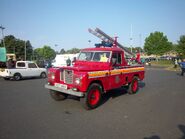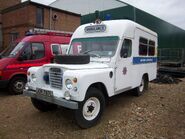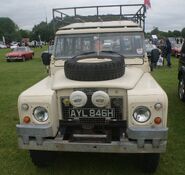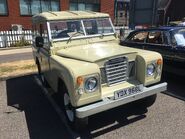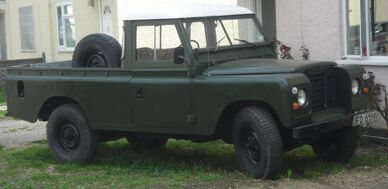
Land Rover Series III
The Series III had the same body and engine options as the preceding IIa, including station wagons and the 1 Ton versions. Little changed cosmetically from the IIA to the Series III. The Series III is the most common Series vehicle, with 440,000 of the type built from 1971 to 1985. The headlights were moved to the wings on late production IIA models from 1968/9 onward (ostensibly to comply with Australian, American and Dutch lighting regulations) and remained in this position for the Series III.
The Series III had the same body and engine options as the preceding IIa, including station wagons and the 1 Ton versions. Little changed cosmetically from the IIA to the Series III. The Series III is the most common Series vehicle, with 440,000 of the type built from 1971 to 1985. The headlights were moved to the wings on late production IIA models from 1968/9 onward (ostensibly to comply with Australian, American and Dutch lighting regulations) and remained in this position for the Series III. The traditional metal grille, featured on the Series I, II and IIA, was replaced with a plastic one for the Series III model. The 2.25-litre engine had its compression raised from 7:1 to 8:1, increasing the power slightly (the high compression engine had been an optional fit on the IIa model for several years). During the Series III production run from 1971 until 1985, the 1,000,000th Land Rover rolled off the production line in 1976. The Series III saw many changes in the later part of its life as Land Rover updated the design to meet increased competition. This was the first model to feature synchromesh on all four gears, although some late H-suffix SIIA models (mainly the more expensive Station Wagons) had used the all-synchro box. In keeping with early 1970s trends in automotive interior design, both in safety and use of more advanced materials, the simple metal dashboard of earlier models was redesigned to accept a new moulded plastic dash. The instrument cluster, which was previously centrally located, was moved to the driver's side. Long-wheelbase Series III vehicles had the Salisbury rear axle as standard, although some late SIIA 109-inch (2,800 mm) vehicles had them too.
In 1980, the 4-cylinder 2.25-litre engines (both petrol and diesel) were updated with five-bearing crankshafts to increase strength in heavy duty work. At the same time the transmission, axles and wheel hubs were re-designed for increased strength. This was the culmination of a series of updates to the transmission that had been made since the 1960s to combat the all-too-common problem of the rear axle half-shafts breaking in heavy usage. This problem was partly due to the design of the shafts themselves. Due to the fully floating design of the rear wheel hubs, the half shafts can be removed very quickly without even having to jack the vehicle off the ground. The tendency for commercial operators to overload their vehicles exacerbated this flaw which blighted the Series Land Rovers in many of their export markets and established a reputation that continues in many markets to the present day. This is despite the 1982 re-design (mainly the changing of the driveshafts from 10 driving-splines to 24 to reduce stress) all but solved the problem.
Also, new trim options were introduced to make the interior more comfortable if the buyer so wished (many farmers and commercial users preferred the original, non-trimmed interior).
These changes culminated in April 1982 with the introduction of the "County" spec Station Wagon Land Rovers, available in both 88-inch (2,200 mm) and 109-inch (2,800 mm) types. These had all-new cloth seats from the Leyland T-45 Lorry, soundproofing kits, tinted glass and other "soft" options designed to appeal to the leisure owner/user.
Of more interest was the introduction of the High Capacity Pick Up to the 109-inch (2,800 mm) chassis. This was a pick-up truck load bay that offered 25% more cubic capacity than the standard pick-up style. The HCPU came with heavy-duty suspension and was popular with public utility companies and building contractors.hts were moved to the wings on late production IIA models from 1968/9 onward (ostensibly to comply with Australian, American and Dutch lighting regulations) and remained in this position for the Series III. The traditional metal grille, featured on the Series I, II and IIA, was replaced with a plastic one for the Series III model. The 2.25-litre engine had its compression raised from 7:1 to 8:1, increasing the power slightly (the high compression engine had been an optional fit on the IIa model for several years). During the Series III production run from 1971 until 1985, the 1,000,000th Land Rover rolled off the production line in 1976. The Series III saw many changes in the later part of its life as Land Rover updated the design to meet increased competition. This was the first model to feature synchromesh on all four gears, although some late H-suffix SIIA models (mainly the more expensive Station Wagons) had used the all-synchro box. In keeping with early 1970s trends in automotive interior design, both in safety and use of more advanced materials, the simple metal dashboard of earlier models was redesigned to accept a new moulded plastic dash. The instrument cluster, which was previously centrally located, was moved to the driver's side. Long-wheelbase Series III vehicles had the Salisbury rear axle as standard, although some late SIIA 109-inch (2,800 mm) vehicles had them too.
In 1980, the 4-cylinder 2.25-litre engines (both petrol and diesel) were updated with five-bearing crankshafts to increase strength in heavy duty work. At the same time the transmission, axles and wheel hubs were re-designed for increased strength. This was the culmination of a series of updates to the transmission that had been made since the 1960s to combat the all-too-common problem of the rear axle half-shafts breaking in heavy usage. This problem was partly due to the design of the shafts themselves. Due to the fully floating design of the rear wheel hubs, the half shafts can be removed very quickly without even having to jack the vehicle off the ground. The tendency for commercial operators to overload their vehicles exacerbated this flaw which blighted the Series Land Rovers in many of their export markets and established a reputation that continues in many markets to the present day. This is despite the 1982 re-design (mainly the changing of the driveshafts from 10 driving-splines to 24 to reduce stress) all but solved the problem.
Also, new trim options were introduced to make the interior more comfortable if the buyer so wished (many farmers and commercial users preferred the original, non-trimmed interior).
These changes culminated in April 1982 with the introduction of the "County" spec Station Wagon Land Rovers, available in both 88-inch (2,200 mm) and 109-inch (2,800 mm) types. These had all-new cloth seats from the Leyland T-45 Lorry, soundproofing kits, tinted glass and other "soft" options designed to appeal to the leisure owner/user.
Of more interest was the introduction of the High Capacity Pick Up to the 109-inch (2,800 mm) chassis. This was a pick-up truck load bay that offered 25% more cubic capacity than the standard pick-up style. The HCPU came with heavy-duty suspension and was popular with public utility companies and building contractors.
Gallery[]
| Land Rover vehicles | |
|---|---|
| Classic production vehicles
|
|




